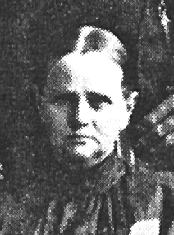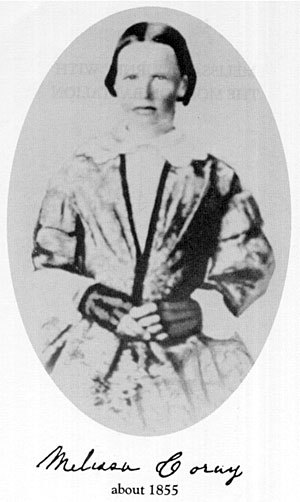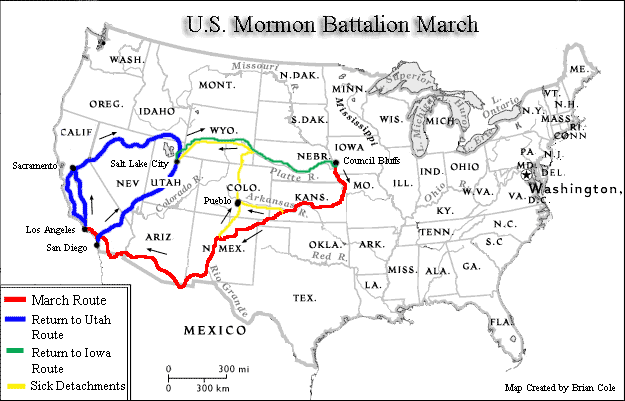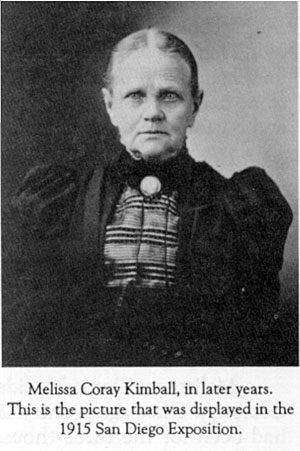The Mormon Battalion
The following was assembled from several web sites by: Earl S. Cory
Sgt. William Coray was the great-grandson of Elnathan Cory. Elnathan and family moved from Southold, Long Island to Goshen, New York then to Wyoming Valley, Lucerne County, Pennsylvania in 1774. It was here that John, his son, changed the spelling of the surname to CORAY.
Sgt. William Coray (Silas-7, John A-6, Elnathan-5, Jonathan-4, Jonathan-3, Isaac-2, John-1) was born on 13 May 1823 in Dansville, Steuben Co, NY. He died on 7 Mar 1849 in Salt Lake City, Salt Lake Co, UT and is buried there.
A mountain peak in eastern California now honors the memory of a Mormon pioneer woman and the "thousands of emigrant women who endured similar hardships in settling the West." The United States Board of Geographic Names in October 1994 named the 9,763-foot peak in the Sierra Nevada mountains in honor of Melissa Coray, the wife of Mormon Battalion Sgt. William Coray. Sgt. Coray was among 45 battalion men who blazed the "highway" through Carson Pass, about 50 miles southwest of present-day Carson City, Nev.
The Mormon Battalion was commanded by Col. Philip St. George Cooke. This group of over 500 men and women had been recruited near Council Bluffs, Iowa during mid-summer, 1846. At this time, the Mormons were still picking up the pieces of their lives and religion after the murder of Joseph Smith in Nauvoo, Illinois in 1844. Under the leadership of Brigham Young, the Mormons were in the process of moving their entire population beyond the western border of the United States to free themselves from the violent persecution they had faced in New York, Ohio and finally in Illinois.
 Melissa Burton
Coray Kimball was the youngest of the four women who made the entire march of the Mormon Battalion. She was born March
2, 1828, in Mersey, Essex, Ontario Canada (daughter of Samuel Burton and Hannah Shipley), and at the age of ten, joined
the Mormon Church. With the rest of her family, she began the march westward, with the body of the Latter Day Saints.
Melissa Burton
Coray Kimball was the youngest of the four women who made the entire march of the Mormon Battalion. She was born March
2, 1828, in Mersey, Essex, Ontario Canada (daughter of Samuel Burton and Hannah Shipley), and at the age of ten, joined
the Mormon Church. With the rest of her family, she began the march westward, with the body of the Latter Day Saints.
Due to stereotypes and misunderstandings on both sides, the government of the United States, considering the Mormons a hostile force, was ready to intercept the Mormons should they cross the Rocky Mountains. Hearing of this, the Mormon leadership sent letters to Stephen A. Douglas and other members of Congress to persuade the government that there was no hostile plan on the Mormons' part to ally with other nations against the US. It was at this time that Mormon leadership also began to lay plans to obtain government patronage while journeying west. Eventually, the decision was made to invade California, and President Polk issued an order that a battalion of men was to be drawn from the Mormon emigrants then in Iowa. This not only enabled the almost destitute Mormons to travel west, but also reinforced General Stephen Watts Kearny's Army of the West. The Mormons set out on their journey at the end of July, 1846.
The 18-year-old was among about 2,000 Mormon refugees at Mt. Pisgah, Iowa, when she married William Coray on June 22, 1846, according to Melissa's Journey with the Mormon Battalion, by Norma B. Ricketts. She was living there as a bride of three months, when the call came for the Mormon Battalion. Melissa knew that her young husband would enlist. He was a military man, having served with the Nauvoo Legion. She was accustomed to placing her faith in God and to taking the advice of those in authority, nevertheless she rebelled at the proposed separation from her husband.
"If he must go, I want to go," she said. "Why must women always stay behind and worry about their husbands, when they could just as well march beside them."
When William told her that there were to be four women with each company employed as laundresses, she saw a way whereby she might go with him. He was a Sergeant in Company B, and if she were in the same company, it would be entirely safe and proper.
Four days after the marriage, the U.S. Army requested the enlistment of 500 Mormons for the war with Mexico. William Coray was among those who followed Brigham Young's counsel to join. Melissa signed on as a laundress and was assigned with her husband to Company B.
On July 13, 1846, William and Melissa arrived at Council Bluffs, Iowa, with other volunteers, and on July 20, they marched to Fort Leavenworth, Kan., and from there on to California.
She said that one of the hardest parts of the journey was leaving her father and mother, but as it was a choice between them and her husband, she thought her duty was to her husband. She never saw her parents again. Once in a while she would tell us an incident of her journey that was especially interesting. She was inclined to belittle the walking she did, although other members of the Battalion said that she traveled on foot a large part of the 2,000 miles to San Diego and most of the return journey to Salt Lake. "I didn't mind it," she declared. "I walked because I wanted to; my husband had to walk, and I went along by his side." She said many times they had very little food and less water, but she and her husband got along very well. Many of the men in the Battalion ate until they were satisfied. The result was that they consumed their food at the start and did not have any later on when they needed it badly.
But not so with the Coray couple. She had learned differently from experience. She looked ahead and figured how many days the food would have to last until they met the next supply company, and then she used only so much each day. She tried to cook wisely, so that no food would be wasted. Although they did not have all they wanted to eat, they were never in danger of starving. She went from campfire to campfire, urging more care in the use of food. She used to relate how, weary and footsore, they had to walk miles and miles without water, and often the men thought they would die of thirst: "That is something," she said, "that only gets worse when you think of it. When I was thirsty, I tried not to think of it." It was at such a time that she learned to carry a pebble in her mouth. This caused the saliva to flow more freely and lessened her unquenchable thirst.
When the Battalion reached Santa Fe, Colonel Cooke decided to send the women and children and sick soldiers to Pueblo for the winter. At this, Melissa Coray almost lost courage. But it was not so with her husband. Along with Capt. Davis, Capt. Hunter and Sergeant Brown, he went to the Colonel to persuade him to let the four women continue. Just what was said at this conference, the women never knew, but they were permitted to accompany their husbands. She said it was a sad day when they had to bid their companions good bye.
The nausea of early pregnancy made traveling harder for her, and she had to hide it as long as possible. Once, after marching two days without water, she saw a number of men crowded around a small spring from which trickled a little stream of water. As it seeped from the rocks they were sucking it through a quill. She said it was such sights as this that made one's heart almost fail.
William attempted to keep many of the trials of the trip from her, but she knew and shared most of them. One night in Arizona she had a scare that she didn't forget. Mexicans were in the vicinity, and the men were afraid they would be attacked, so they stayed up all night, but nothing happened. About this time, she was becoming extremely weary and footsore, and Col. Cooke seeing her fatigue, got down from his big white horse and offered it to her to ride on. In relating this to her grandchildren, she was always careful to designate "white horse" as though this made the event more important.
A journal entry from January 16, 1847 gives us a glimpse of the hardships endured by the Battalion:
"Marched 25 miles to water by 2 o'clock, though part of the command did not get to the camp during the day, such was the extreme suffering of the Mormon Battalion. Three days without water and if the fresh beef had not met us nothing could have saved our lives but the unseen hand of Almighty God, as the most of us were without bread stuff entirely...the worst place we had encountered since we left the States."Ricketts, 61
Up until this time, travel through the desert southwest had been only on horseback or on foot. The Mormons brought wagons, and blazed a route across the region that would be followed for the next century and more. Their route became used as the Southern Overland Trail, and is today the approximate route of Interstate 8 between Yuma and San Diego. Ricketts goes on to detail the Battalions' approach to Vallecito across the Carrizo Badlands;
"The men were so used up from thirst, fatigue, and hunger, there was no talking. Some could not speak at all; tongues were swollen and dark. Sixteen more mules gave out. Each man was down to his last four ounces of flour; there had been no sugar or coffee for weeks. Only five government wagons and three private wagons remained...When they arrived at Vallecito Creek, they rested and washed clothes and cleaned their guns. An Indian from a nearby village brought a letter from the alcalde in San Diego welcoming the Battalion to California. In the early evening there was singing and fiddling with a little dancing."Ricketts, 61
By the 21st of January, the Battalion arrived at Warner's Ranch Near Mt. Palomar. On their way there, they had literally hacked their way through Box Canyon with axes to make room for the remaining wagons. Box Canyon is now a State landmark. Another journal entry reads:
"This was a hard day's march though only 10 miles were traveled. We encountered one hill that was almost impracticable, [Campbel Grade north of Vallecito], but the pioneers rolled the largest stones out of the way and we passed on, winding our way up a creek through a very narrow pass, [Box Canyon]. By means of axes we cut the rocks so the wagons could pass and went up and camped on the top of the mountain without water, [Blair Valley?]."Ricketts, 62
 On Jan. 29, 1847, the Mormon Battalion reached Mission San Diego, Calif and She
and Sergeant Coray, with others of the Battalion thought their journey ended. After two days there, they were ordered
to the Mission San Luis Rey to do garrison duty and protect the place from the Indians. However, in six weeks or so
Company B was ordered back to San Diego and she said they camped at Old Town, near the site which is now known as Ramona's
marriage place. On March 17, 1847, Company B - which included William and Melissa - arrived in San Diego and took over
operation of Fort Stockton. In July, they marched to Los Angeles where the battalion was disbanded. Here she anxiously
awaited the time when her husband would be mustered out and could make a home for her and the baby she was expecting.
When the Battalion was discharged in early summer, her husband bought a wagon and some horses, and they started north.
On Jan. 29, 1847, the Mormon Battalion reached Mission San Diego, Calif and She
and Sergeant Coray, with others of the Battalion thought their journey ended. After two days there, they were ordered
to the Mission San Luis Rey to do garrison duty and protect the place from the Indians. However, in six weeks or so
Company B was ordered back to San Diego and she said they camped at Old Town, near the site which is now known as Ramona's
marriage place. On March 17, 1847, Company B - which included William and Melissa - arrived in San Diego and took over
operation of Fort Stockton. In July, they marched to Los Angeles where the battalion was disbanded. Here she anxiously
awaited the time when her husband would be mustered out and could make a home for her and the baby she was expecting.
When the Battalion was discharged in early summer, her husband bought a wagon and some horses, and they started north.
From there, the discharged battalion members split into several groups for the trip to the Salt Lake Valley. The Corays joined a small party led by Capt. Jefferson Hunt. They traveled up the coast to Monterey. There, on Oct. 2, Melissa gave birth to a son, but he only lived a few days and was buried in the little cemetery there. As soon as she was able to travel, they started out again. She said the trip was hard; the country was new; and there were no roads. They had to pick their way as best they could. In one place they came to a gorge so narrow that they couldn't drive through it. They had to take their wagon apart and carry it through, a piece at a time.
When they reached Sutter's Mill they found that gold had been discovered, and some of the Battalion stopped there. Although the Corays were anxious to get to Salt Lake, they had to remain there long enough to get the means to continue. Mr. Coray sent two sacks of gold back east to bring his mother and sister to Utah. On Monday, the main company of returning Mormon Battalion veterans started their journey over the mountains. They left for Utah with the Browett-Holmes Company from Pleasant Valley, near present-day Placerville. The company consisted of 45 men, one woman (Melissa), two cannons, 17 wagons, 150 mules and horses and about the same number of cattle. On July 4th in Pleasant Valley, California, they recognized Independence Day by firing two rounds from a cannon. Addison Pratt wrote: "With these [cannons] we saluted the day, which made the mountains ring."
They chose the Carson Pass route to avoid crossing the Truckee River numerous times. It took them six weeks to build a wagon trail over Carson Pass. These were the first wagons to travel this route and the first to go from west to east, according to SUP press releases.

Map created by Brian Cole. Courtesy of the Mormon Battalion Association.
She said the worst night she ever spent was in Nevada. An advance guard of five men had been sent ahead to find the best route and notify the others. But they weren't heard from. Although the rest of the party thought it strange, they kept on. One night, just at dusk, they came upon the bodies of the five men. They had been killed by the Indians with poisoned arrows, and their bodies had been thrown in a gulch and partly covered with underbrush. The bodies were buried, and the small company camped nearby for the night. They had bought a small cannon before leaving San Diego. They were afraid of an attack that night so the cannon was fired off every little while to scare the Indians. "The firing of the cannon may have kept the Indians away, but it did us more harm than good, for it frightened our horses so that they stampeded, and we had a hard time getting them back, and some never came back."
For Melissa Coray, this had been the second time she had watched the battalion build a road. The first was the last 700 miles to San Diego. Melissa witnessed a third building of a road - the Salt Lake Cut-off just before arriving in the Great Salt Lake Valley Oct. 6, 1848.
All together, Melissa witnessed nearly 1,000 miles of road building.
We arrived in Salt Lake City in December, 1848, and were glad to get here." She and her husband established their home in the first house built in the old Fifteenth Ward, and it was here that a baby girl was born to them, February 6, 1849. She was Melissa Coray Swan, who, in later years, made her home in Ocean Park, California.
Grief soon entered the Coray household. Sergeant Coray, weakened by the hardships and exposure of the trip, took seriously ill and passed away in March, 1849, less than three months after arriving here. Two years later, she married William H. Kimball, eldest son of Heber C. Kimball. She spent the rest of her life in Utah and died in Salt Lake City, September 21, 1903.
 Her picture was in the Utah Building during the San Diego Exposition in 1915. Several
years before she died, she made a trip to California, visiting the places where she had been so many years before. She
stopped at San Luis Rey mission, which was really her first stopping place in California. She talked with the priests
there and could hardly get away from them, they were so anxious to hear her story. She also visited Monterey and tried
to locate the grave of her baby, but the cemetery had changed so that she was unable to do so.
Her picture was in the Utah Building during the San Diego Exposition in 1915. Several
years before she died, she made a trip to California, visiting the places where she had been so many years before. She
stopped at San Luis Rey mission, which was really her first stopping place in California. She talked with the priests
there and could hardly get away from them, they were so anxious to hear her story. She also visited Monterey and tried
to locate the grave of her baby, but the cemetery had changed so that she was unable to do so.
She had two children with her first husband including the one who died shortly after birth, and six children with her second husband.
During the years of the California gold rush, 1849-56, the preferred "highway" across the Sierra Nevada, which was blazed by discharged members of the Mormon Battalion - accompanied by one woman - was traveled by some 200,000 westbound gold seekers and settlers.
Melissa spent the rest of her life in Utah and died in Salt Lake City, September 21, 1903 at the age of 75 years. Her funeral was held on Wednesday, September 23, 1903 in the Fifteenth Ward Chapel. Apostles Orson F. Whitney and Elder Nephi L. Morris spoke. Benediction by J. Golden Kimball. Melissa was buried beside her first husband William Coray in the Salt Lake City Cemetery.

